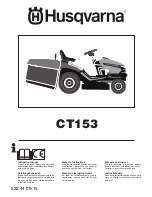
- 14 -
If you notice any malfunctions, stop the machine and consult the
chapter “Problems, causes and solutions”.
Turn the machine off when not in use.
USER INSTRUCTIONS
After reading the previous chapters carefully, apply these instructions
scrupulously to obtain maximum performance.
Proceed calmly so as to become familiar with all the controls; after
having gained sufficient experience, you will be able to make full use
of its capacities.
BLADE
The type, size and efficiency of the blade (pos. 26) are essential for a
successful outcome of the work you are about to do; keep it always
sharpened and in perfect condition.
Viewed from below (assembly position), it should rotate in an anti-
clockwise direction. Each end consists of a cutting edge (on the
direction of rotation), and a side bent towards the inside of lawnmower
casing. When the short side is half consumed due to sharpening,
then it is time to replace it.
The characteristic size of the blade is the diagonal measurement of
the long side (cutting diameter): follow the technical specifications
attached to find the cutting size and install the correct replacement.
MOWING THE LAWN
Proceed calmly and carefully follow the instructions below:
• Study figure L and act accordingly.
• Eliminate from the lawn any foreign objects, such as rocks, wires,
pipes, branches and objects, etc. Pay attention to sumps and
protruding sprinklers.
• Avoid trampling on grass and crushing it.
• Wear the personal protective equipment listed in the “Warnings”
chapter.
• Sharpen the blade.
• Check engine oil level.
• Get the necessary fuel, a funnel and a rag, and refill the tank. Do
not refill the tank on the lawn as the fuel is poisonous to grass.
• Adjust the cutting height by changing the distance between the blade
and the soil (fig. G). Grab the adjustment lever (pos. 25) and, as
shown in the figure, insert it in one of the slots on the casing. We
recommend cutting no more than 1/3 of the grass strand, in order
to avoid damaging the plants and preventing future growth. If the
grass is tall and/or particularly thick, you will have to go over it two
or more times, gradually adjusting the cutting height.
The lawnmower can perform several functions, collecting, discharging
or mulching the cut grass:
• Cutting with grass collection (fig. A): install the grass collection
box (pos. 15) and check that the doors are closed.
Model with side deflector
• Cutting with side discharge (fig. P-Q): install the deflector (pos.
29) and the discharge closure (pos. 30) in the casing, remove the
collection box and close the rear door.
Use for particularly tall, unkempt grass, if you wish to leave the
grass to dry and collect at a later time.
Mulching model
• Mulch cutting without discharge (fig. Q): install the discharge
closure (pos. 30), remove the collection box and close the rear and
side doors. Use for trimmed grass and minor, frequent mowing; the
cut grass will become a fertiliser. We recommend aerating the soil
several times a year.
Operator:
Hold the position of use shown in figure L, with the lawnmower in front
of you; the upper handle will keep you at a distance from the cutting
area. Never be on the side or in front of the lawnmower.
If using the lawnmower without grass collection box, pay attention
to the movement of your feet, which must always remain at a safe
distance; in particular, pay close attention when moving the lawnmo-
wer backwards, when reversing, and when mowing along a slope.
To prevent muscular problems due to poor posture, try to keep
your back straight as much as possible and avoid leaning forward,
stretch your arms forward and keep your balance without leaning
on the handle.
Moving forward:
• Push model:
Grip the upper handle with both hands, walk slowly and push the
lawnmower forward.
• Model with drive:
After starting the engine, press the forward clutch lever (where
fitted, pos. 3) to move the lawnmower forwards. Adjust your pace
to the speed rate, without stopping or speeding up, or holding or
pushing the lawnmower.
Where fitted, operate the lever to adjust the speed rate (pos. 34)
to suit your needs.
To stop the lawnmower, release the lever (pos. 3).
Note: while starting up the engine, do not press the forward clutch
lever.
Mowing:
Using the safety earmuffs also attenuates any warning sounds used
to draw your attention (such as the horn of a vehicle): therefore, do
not station yourself in transit areas and always closely observe the
area in which you operate.
Start the lawnmower on a clean, non-grassy area, and begin mowing
the lawn straight away. We recommend going along the long side of
the lawn, in parallel lines, to reduce the number of direction changes
to a minimum and achieve a good visual effect of mown grass.
Avoid going over piles of previously mown grass so as to avoid
clogging the discharge and overloading the engine.
When the grass collection box is full, switch off the engine, wait for
the blade to come to a stop and disconnect the spark plug cap, before
unhooking the box to empty it.
The rotation of the blade, in addition to mowing grass, creates an
air vortex that suctions the cut grass and any other object under the
casing and its immediate vicinity; pay attention when going along
the edges of the lawn not to suction pebbles, lapilli, bark, etc. that
could damage the machine and get thrown around with the danger
of hitting persons or property.
Pay attention to obstacles (protruding roots, sumps, pavement, spot-
lights, etc.), keep a distance as you go around them, and afterwards
trim around them with a pair of scissors or an edger.
Do not bump the machine against fixed obstacles such as walls,
fences, tree trunks, etc. because the machine could be damaged.
If necessary and in case of danger, release the lever (pos. 2) to turn
off the engine.
MAINTENANCE
!
!
WARNING! Each operation indicated below must be carried
out while the engine is off, the blade stopped, the spark plug cap
disconnected and the engine cooled to ambient temperature.
!
!
WARNING! Do not tamper with or attempt to repair this machine.
!
!
WARNING! If in doubt, contact an authorised service centre.
Clean and maintain your machine regularly, to ensure that it remains
perfectly efficient and has a long working life.
Summary of Contents for MTosSco
Page 9: ... 9 ...


































